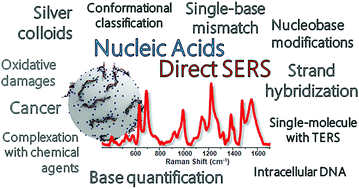当前位置:
X-MOL 学术
›
Chem. Soc. Rev.
›
论文详情
Our official English website, www.x-mol.net, welcomes your
feedback! (Note: you will need to create a separate account there.)
Direct surface-enhanced Raman scattering (SERS) spectroscopy of nucleic acids: from fundamental studies to real-life applications†
Chemical Society Reviews ( IF 40.4 ) Pub Date : 2018-05-02 00:00:00 , DOI: 10.1039/c7cs00809k Eduardo Garcia-Rico 1, 2, 3, 4, 5 , Ramon A. Alvarez-Puebla 3, 6, 7, 8, 9 , Luca Guerrini 3, 6, 7
Chemical Society Reviews ( IF 40.4 ) Pub Date : 2018-05-02 00:00:00 , DOI: 10.1039/c7cs00809k Eduardo Garcia-Rico 1, 2, 3, 4, 5 , Ramon A. Alvarez-Puebla 3, 6, 7, 8, 9 , Luca Guerrini 3, 6, 7
Affiliation

|
Plasmonic optical biosensors for the analysis of nucleic acids have drawn a great deal of interest in nanomedicine because of their capability to overcome major limitations of conventional methods. Within this realm, surface-enhanced Raman scattering (SERS)-based sensing is progressively emerging as a powerful analytical tool beyond the basic grounds of academia to viable commercial products. SERS benefits from the synergistic combination between the intrinsic structural specificity and experimental flexibility of Raman spectroscopy, the extremely high sensitivity provided by plasmonic nanomaterials, and the tremendous advances in nanofabrication techniques and spectroscopic instrumentation. SERS application to nucleic acids analysis has been largely restricted to indirect sensing approaches, where a SERS reporter and oligonucleotide ligands are typically combined onto the nanomaterials to enable extrinsic detection of the target sequences. On the other hand, the acquisition of the intrinsic SERS vibrational fingerprint of nucleic acids (direct sensing) has traditionally suffered from major limitations. However, recent years have witnessed a burst of interest in this area, largely driven by the efforts to address key reproducibility and sensitivity issues. In this tutorial review, we summarize and discuss the most recent cutting-edge research in the field of direct SERS sensing of nucleic acids by coherently organising the diverse data reported in the literature in a structurally logical fashion.
中文翻译:

核酸的直接表面增强拉曼散射(SERS)光谱:从基础研究到实际应用†
等离子光学生物传感器用于核酸分析已经引起了人们对纳米医学的极大兴趣,因为它们具有克服常规方法的主要局限性的能力。在这一领域中,基于表面增强拉曼散射(SERS)的传感已逐渐成为一种强大的分析工具,其范围已超出学术界的基本基础,已成为可行的商业产品。SERS受益于拉曼光谱的固有结构特异性和实验灵活性,等离子体纳米材料提供的极高灵敏度以及纳米制造技术和光谱仪器的巨大进步之间的协同结合。SERS在核酸分析中的应用在很大程度上已限于间接感测方法,其中SERS报告基因和寡核苷酸配体通常结合到纳米材料上,以实现靶序列的外在检测。另一方面,核酸的固有SERS振动指纹的获取(直接感测)传统上受到主要限制。但是,近年来,在这一领域引起了人们的浓厚兴趣,这在很大程度上是为解决关键的可重复性和敏感性问题而做出的努力。在本教程中,我们通过以结构逻辑的方式一致地组织文献中报道的各种数据,总结和讨论了直接SERS核酸检测领域的最新前沿研究。传统上,核酸固有SERS振动指纹(直接感应)的获取受到重大限制。但是,近年来,在这一领域引起了人们的浓厚兴趣,这在很大程度上是为解决关键的可重复性和敏感性问题而做出的努力。在本教程中,我们通过以结构逻辑的方式一致地组织文献中报道的各种数据,总结和讨论了直接SERS核酸检测领域的最新前沿研究。传统上,核酸固有SERS振动指纹(直接感应)的获取受到重大限制。但是,近年来,在这一领域引起了人们的浓厚兴趣,这在很大程度上是为解决关键的可重复性和敏感性问题而做出的努力。在本教程中,我们通过以结构逻辑的方式一致地组织文献中报道的各种数据,总结和讨论了直接SERS核酸检测领域的最新前沿研究。
更新日期:2018-05-02
中文翻译:

核酸的直接表面增强拉曼散射(SERS)光谱:从基础研究到实际应用†
等离子光学生物传感器用于核酸分析已经引起了人们对纳米医学的极大兴趣,因为它们具有克服常规方法的主要局限性的能力。在这一领域中,基于表面增强拉曼散射(SERS)的传感已逐渐成为一种强大的分析工具,其范围已超出学术界的基本基础,已成为可行的商业产品。SERS受益于拉曼光谱的固有结构特异性和实验灵活性,等离子体纳米材料提供的极高灵敏度以及纳米制造技术和光谱仪器的巨大进步之间的协同结合。SERS在核酸分析中的应用在很大程度上已限于间接感测方法,其中SERS报告基因和寡核苷酸配体通常结合到纳米材料上,以实现靶序列的外在检测。另一方面,核酸的固有SERS振动指纹的获取(直接感测)传统上受到主要限制。但是,近年来,在这一领域引起了人们的浓厚兴趣,这在很大程度上是为解决关键的可重复性和敏感性问题而做出的努力。在本教程中,我们通过以结构逻辑的方式一致地组织文献中报道的各种数据,总结和讨论了直接SERS核酸检测领域的最新前沿研究。传统上,核酸固有SERS振动指纹(直接感应)的获取受到重大限制。但是,近年来,在这一领域引起了人们的浓厚兴趣,这在很大程度上是为解决关键的可重复性和敏感性问题而做出的努力。在本教程中,我们通过以结构逻辑的方式一致地组织文献中报道的各种数据,总结和讨论了直接SERS核酸检测领域的最新前沿研究。传统上,核酸固有SERS振动指纹(直接感应)的获取受到重大限制。但是,近年来,在这一领域引起了人们的浓厚兴趣,这在很大程度上是为解决关键的可重复性和敏感性问题而做出的努力。在本教程中,我们通过以结构逻辑的方式一致地组织文献中报道的各种数据,总结和讨论了直接SERS核酸检测领域的最新前沿研究。











































 京公网安备 11010802027423号
京公网安备 11010802027423号